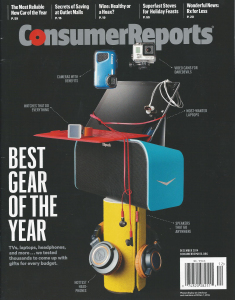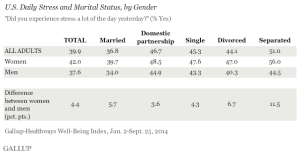This post is written as part of the Disruptive Women on Health’s blog-fest celebrating the 2014 mHealth Summit taking place 7-11 December 2014 in greater Washington, DC.
Women and mobile health: let’s unpack the intersection.
On the supply side of the equation, Good Housekeeping covered health tracking-meets-fashion bling in the magazine a few weeks ago in article tucked between how to cook healthy Thanksgiving side dishes and tips on getting red wine stains out of tablecloths. This ad appeared in a major sporting goods chain’s 2014 Black Friday pre-print in my city’s newspaper last week. And along with consumer electronics brand faves like Apple, Google, Microsoft, and Samsung, Sony’s plans for a watch were hiding in plain sight on a Japanese crowdfunding site since September 2014; speaking of fashion-meets-wearables, the strap is designed to morph into 24 different designs.
 Consumer Reports December 2014 issue features the Best Gear of the Year, with a section on mobile gear including a sidebar on smart watches (with CR’s proviso that, “for all of the excitement, there’s still no consensus on what, exactly, a smart watch should do). While all pair with mobile platforms and apps, some serve as health and fitness trackers. While there were a handful of these at the 2014 Consumer Electronics Show, I’ve got extra-comfortable shoes packed up for my January 2015 trek to Las Vegas 2015 CES where I know I’ll be kicking the proverbial tires on well over a dozen health-inside smart watches: Samsung’s Gear S and Gear Fit, the Apple Watch (with HealthKit), the Pebble (which pioneered this category so has some maturity-cred in its favor).
Consumer Reports December 2014 issue features the Best Gear of the Year, with a section on mobile gear including a sidebar on smart watches (with CR’s proviso that, “for all of the excitement, there’s still no consensus on what, exactly, a smart watch should do). While all pair with mobile platforms and apps, some serve as health and fitness trackers. While there were a handful of these at the 2014 Consumer Electronics Show, I’ve got extra-comfortable shoes packed up for my January 2015 trek to Las Vegas 2015 CES where I know I’ll be kicking the proverbial tires on well over a dozen health-inside smart watches: Samsung’s Gear S and Gear Fit, the Apple Watch (with HealthKit), the Pebble (which pioneered this category so has some maturity-cred in its favor).
That’s a very brief snapshot on today’s consumer-facing mobile health landscape. You can read lots more here and elsewhere on Health Populi (just search the box for “mobile health”).
Now, to the demand side: in addition to the Electronics Gift Guide, Consumer Reports provides a special feature called A Beautiful Death, about how to make your own terms with dying at the end-of-life. And, on page 20, CR has an update on How to Save Big on Rx, comparing the prices of the same five popular drugs sold at different stores.
Welcome to the personal health ecology of a woman. Health is where she lives, works, plays, prays, learns, sleeps, cooks, and banks.
Thus we come to the reality of a woman’s life in the U.S.: that she is generally stressed out, financially worried, time-constrained, and still worried about weight. Even rich girls worry about being bag ladies, I wrote last month in The Huffington Post. Between flat wage growth, increasing health care costs, and getting “sidetracked by life events” according to CIGNA, she needs help in finding the on-ramp to mindfulness and personal peace. She’s bombarded with conflicting information about nutrition (the latest: good fat versus bad fat, and the case for/against dietary supplements), treatments for menopause — cognitive therapy and mindfulness? hormone replacement treatment?; dealing with a growing alcohol problem; caregiver stress; and, the impact of social media and cell phones on her kids. Furthermore, if she’s divorced, she’s much less well and well-off, based on a recent Gallup Poll.
 At least one-half of women who work outside the home receive health insurance from work, and a plurality of married women is covered by health insurance through their spouses’ employers. While being nudged into high-deductible health plans coupled with health savings accounts, peoples’ employers are coupling the “skin in the game” approach to sharing health costs with wellness programs that incorporate “the quantified workplace.” Jody Ranck coins this phrase in the title of his latest Gigaom Research report, where he analyzes the diverse array of employee wellness programs that target biometrics and integrate the use of digital health tracking devices. For example, HumanaVitality, Hubbub (from Cambia Health) and Jiff all incorporate various health trackers into their programs including Fitbit, Misfit, Moves, Withings, and Runkeeper, among others..
At least one-half of women who work outside the home receive health insurance from work, and a plurality of married women is covered by health insurance through their spouses’ employers. While being nudged into high-deductible health plans coupled with health savings accounts, peoples’ employers are coupling the “skin in the game” approach to sharing health costs with wellness programs that incorporate “the quantified workplace.” Jody Ranck coins this phrase in the title of his latest Gigaom Research report, where he analyzes the diverse array of employee wellness programs that target biometrics and integrate the use of digital health tracking devices. For example, HumanaVitality, Hubbub (from Cambia Health) and Jiff all incorporate various health trackers into their programs including Fitbit, Misfit, Moves, Withings, and Runkeeper, among others..
But Ranck notes — behavioral psychology and incentive economics underpin the success of these programs. If “She” and her personal health ecology aren’t designed as the user of the digital health tool, we’ll continue to see the disbanding of mobile health devices that survey research finds is about a 3-to-6 month’s adoption, then abandonment, according to Rock Health.
Technology is not the center of Her universe. Mobile health isn’t an end in itself — it is an enabling mode of health care and wellness delivery. But let’s not make mobile health the central noun in the definition of Health and Wellbeing. The nouns therein are “She” and “He.”




 Thanks to Feedspot for naming this blog, Health Populi, as a
Thanks to Feedspot for naming this blog, Health Populi, as a